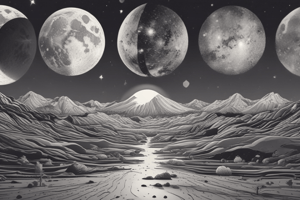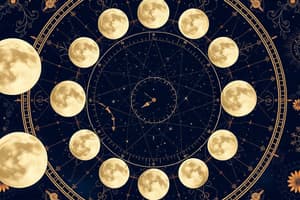Podcast
Questions and Answers
What causes the moon's phases?
What causes the moon's phases?
- Changes in the moon's position relative to the stars
- The reflection of sunlight on its surface (correct)
- The presence of clouds in the Earth's atmosphere
- The moon emitting its own light
When does a new moon occur?
When does a new moon occur?
- When the moon is closer to Earth, causing more illumination
- When the moon is in direct alignment with Mars and Jupiter
- When the moon is directly opposite the Sun, with its fully illuminated side facing Earth
- When the moon is in between the Earth and the Sun, with its side facing Earth not illuminated (correct)
How long does it take for the moon to complete its lunar cycle?
How long does it take for the moon to complete its lunar cycle?
- 29.5 days (correct)
- 15 days
- 22 days
- 35 days
What do the terms 'waxing' and 'waning' refer to?
What do the terms 'waxing' and 'waning' refer to?
What does a full moon occur when?
What does a full moon occur when?
What is the meaning of the phase 'gibbous'?
What is the meaning of the phase 'gibbous'?
What causes different amounts of sunlight to be reflected by the moon, leading to different phases?
What causes different amounts of sunlight to be reflected by the moon, leading to different phases?
Flashcards are hidden until you start studying
Study Notes
- The moon appears to emit light but it's an illusion, as the moon itself does not produce light.
- The moon's phases are due to the reflection of sunlight on its surface.
- The moon's orbit around the Earth causes different amounts of sunlight to be reflected, leading to different phases.
- A new moon occurs when the moon is in between the Earth and the Sun, and its side facing the Earth is not illuminated by sunlight.
- A full moon occurs when the moon's fully illuminated side is facing the Earth, allowing us to see the entire moon's surface lit up.
- The lunar cycle, or phases of the moon, takes about 29.5 days to complete.
- The moon goes through several phases as it orbits the Earth, including crescent, first quarter, waxing gibbous, last quarter, and waning crescent.
- The terms "waxing" and "waning" refer to the moon growing in size (waxing) and shrinking in size (waning).
- The phase "gibbous" comes from the latin word for "hump" and describes a rounded or convex shape, like the moon when it's more than half illuminated.
- The moon takes about 29.5 days to complete its lunar cycle and return to its new moon phase.
Studying That Suits You
Use AI to generate personalized quizzes and flashcards to suit your learning preferences.




